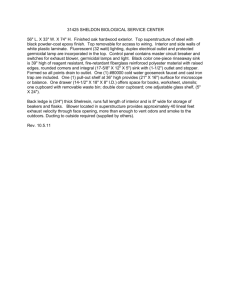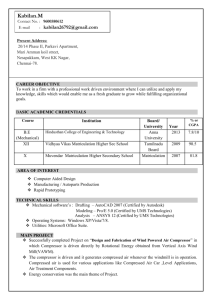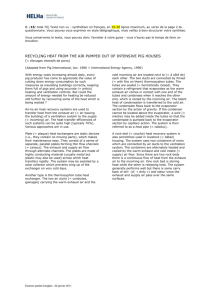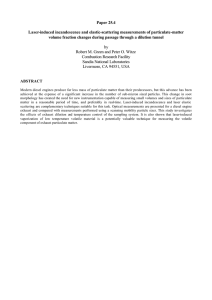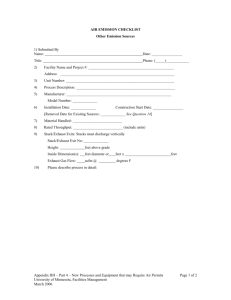TechTopics No. 89 Venting of exhaust gases from arc-resistant equipment www.usa.siemens.com/techtopics
advertisement
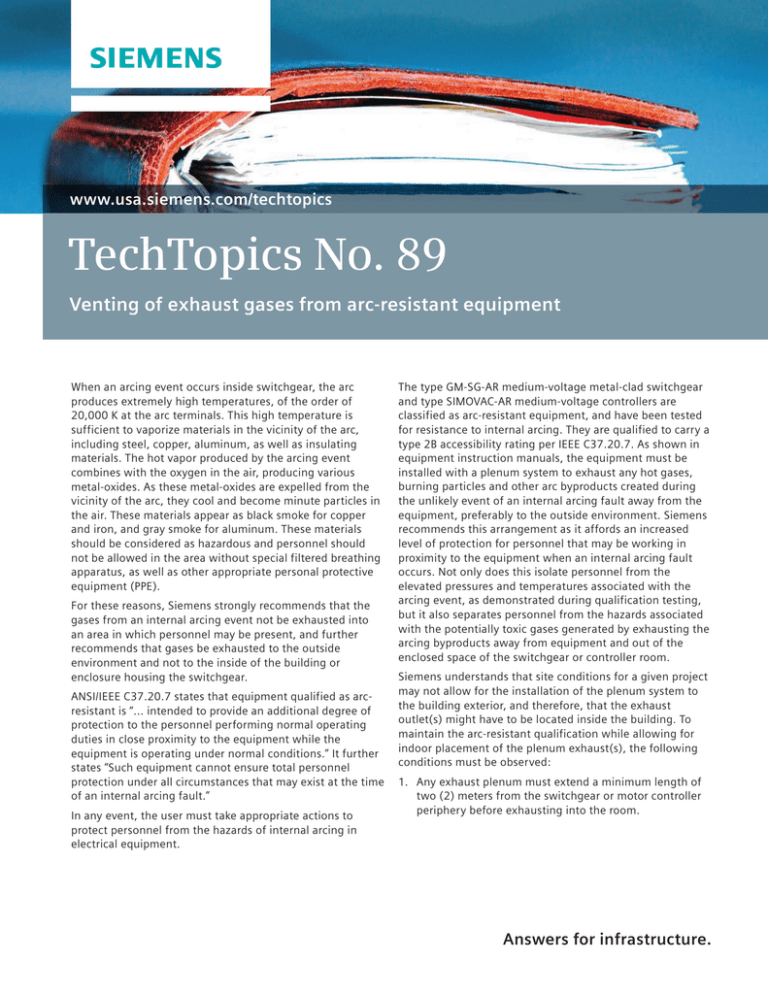
www.usa.siemens.com/techtopics TechTopics No. 89 Venting of exhaust gases from arc-resistant equipment When an arcing event occurs inside switchgear, the arc produces extremely high temperatures, of the order of 20,000 K at the arc terminals. This high temperature is sufficient to vaporize materials in the vicinity of the arc, including steel, copper, aluminum, as well as insulating materials. The hot vapor produced by the arcing event combines with the oxygen in the air, producing various metal-oxides. As these metal-oxides are expelled from the vicinity of the arc, they cool and become minute particles in the air. These materials appear as black smoke for copper and iron, and gray smoke for aluminum. These materials should be considered as hazardous and personnel should not be allowed in the area without special filtered breathing apparatus, as well as other appropriate personal protective equipment (PPE). For these reasons, Siemens strongly recommends that the gases from an internal arcing event not be exhausted into an area in which personnel may be present, and further recommends that gases be exhausted to the outside environment and not to the inside of the building or enclosure housing the switchgear. ANSI/IEEE C37.20.7 states that equipment qualified as arcresistant is “... intended to provide an additional degree of protection to the personnel performing normal operating duties in close proximity to the equipment while the equipment is operating under normal conditions.” It further states “Such equipment cannot ensure total personnel protection under all circumstances that may exist at the time of an internal arcing fault.” In any event, the user must take appropriate actions to protect personnel from the hazards of internal arcing in electrical equipment. The type GM-SG-AR medium-voltage metal-clad switchgear and type SIMOVAC-AR medium-voltage controllers are classified as arc-resistant equipment, and have been tested for resistance to internal arcing. They are qualified to carry a type 2B accessibility rating per IEEE C37.20.7. As shown in equipment instruction manuals, the equipment must be installed with a plenum system to exhaust any hot gases, burning particles and other arc byproducts created during the unlikely event of an internal arcing fault away from the equipment, preferably to the outside environment. Siemens recommends this arrangement as it affords an increased level of protection for personnel that may be working in proximity to the equipment when an internal arcing fault occurs. Not only does this isolate personnel from the elevated pressures and temperatures associated with the arcing event, as demonstrated during qualification testing, but it also separates personnel from the hazards associated with the potentially toxic gases generated by exhausting the arcing byproducts away from equipment and out of the enclosed space of the switchgear or controller room. Siemens understands that site conditions for a given project may not allow for the installation of the plenum system to the building exterior, and therefore, that the exhaust outlet(s) might have to be located inside the building. To maintain the arc-resistant qualification while allowing for indoor placement of the plenum exhaust(s), the following conditions must be observed: ny exhaust plenum must extend a minimum length of 1. A two (2) meters from the switchgear or motor controller periphery before exhausting into the room. Answers for infrastructure. 2. E ach exhaust plenum outlet must be at least 2.4 meters above the floor. The exhaust plenum can exit the equipment in any direction (either side, front, rear, or top of the pressure relief channel), but at the exhaust plenum outlet, the exhaust plenum must be oriented in the horizontal plane. 3. T he outlet(s) must exhaust into a restricted access area that is inaccessible to personnel when the equipment is energized, and free of flammable and or combustible materials. This restricted access area shall extend a minimum of three meters directly in front of the exhaust outlet and 1.5 meters to each side of the exhaust outlet. 5' (1.5 m) 10’ (3 m) 4. Ventilation provisions must be incorporated in the building design to mitigate the hazards associated with potentially toxic gases generated as a result of arcing or its consequences. Such gases may contain vaporized metals and gases from burning insulation materials. ANSI/IEEE C37.20.7 reinforces the restricted area philosophy, stating “Personnel must not be permitted to be in the area of the switchgear pressure-relief vents or in areas to which exhaust gases are vented.” Figure 1: Restricted area required in vicinity of exhaust plenum outlet Figure 1 shows the configuration of the area in the vicinity of the exhaust plenum outlet that must be restricted. Whenever the equipment is energized, the restricted area must be kept clear of personnel and of combustible or flammable materials. The restricted area must not be used for storage of any items. Figures 2 and 3 illustrate the essential concept of the pressure relief channel on top of the equipment, and the exhaust plenum (or duct) that extends away from the equipment to direct the exhaust gases out and away from the equipment. In Figure 2, a group of SIMOVAC-AR medium-voltage controllers is shown, with the exhaust gas path illustrated. Arcing gases are directed to the topmounted pressure relief channel (PRC), and from there to the exhaust plenum. In Figure 3, a group of SIMOVAC-AR medium-voltage controllers (only one section shown) is connected to a group of type GM-SG-AR medium-voltage metal-clad switchgear (again, only one section shown). In this example, the arcing gases are directed to the top-mounted pressure relief chamber (PRC) on the controller, and the PRC is in turn connected to the PRC above the metal-clad switchgear, and a single plenum exhaust duct is used to direct the exhaust gases out and away from the equipment. Figure 2: SIMOVAC-AR exhaust plenum arrangement In either event, the exhaust plenum may exit the top, to the front, to the rear, or to either side of the equipment assembly for flexibility in adaptation to the user’s building. The exhaust end of the plenum must be oriented in the horizontal plane. The exhaust plenum may be of any reasonable length, but must extend at least two meters beyond the periphery of the equipment. Figure 3: SIMOVAC-AR in lineup with GM-SG-AR exhaust plenum arrangement 2 Siemens highly recommends that the gases generated by an internal arcing event be exhausted outside of the building or enclosure that houses the switchgear or motor controllers. We recognize that building conditions may not allow for exhaust outside of the building. In such cases, the user may not have any choice but to exhaust into the building, whether into the equipment room or into another area inside the building. In any event, the user must take appropriate actions to protect personnel from the hazards of internal arcing in electrical equipment, including protection of personnel from the hazards associated with the gases and other byproducts exhausted during an arcing event. The information provided in this document contains merely general descriptions or characteristics of performance which in case of actual use do not always apply as described or which may change as a result of further development of the products. An obligation to provide the respective characteristics shall only exist if expressly agreed in the terms of contract. All product designations may be trademarks or product names of Siemens AG or supplier companies whose use by third parties for their own purposes could violate the rights of the owners. Siemens Industry, Inc. 7000 Siemens Road Wendell, NC 27591 Subject to change without prior notice. Order No.: IC1000-F320-A140-X-4A00 All rights reserved. © 2012 Siemens Industry, Inc. For more information, contact: +1 (800) 347-6659 www.usa.siemens.com/techtopics 3
